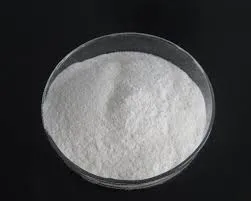
ታኅሣ . 23, 2024 03:02 Back to list
hpmc 4000
Understanding HPMC 4000 A Versatile Polymer in Pharmaceutical Applications
Hydroxypropyl Methylcellulose (HPMC), particularly HPMC 4000, is a widely used excipient in the pharmaceutical industry. This semi-synthetic polymer is derived from cellulose and is noted for its versatility and functionality in various applications, especially in drug formulation. In this article, we will explore the characteristics, applications, and significance of HPMC 4000 in pharmaceuticals.
Characteristics of HPMC 4000
HPMC 4000 is known for its unique physicochemical properties. It is soluble in both cold and hot water, forming a clear, viscous solution. The viscosity of HPMC 4000 is generally in the range of 3000 to 5000 mPa·s, which provides excellent thickening and stabilizing properties. Its polymeric structure contributes to its ability to form films, providing a protective barrier around drugs and improving their stability. Furthermore, HPMC 4000 is non-toxic, biocompatible, and has low irritation potential, making it suitable for oral, parenteral, and topical applications.
Another notable feature of HPMC 4000 is its rheological properties. The polymer exhibits pseudoplastic behavior, which means its viscosity decreases with increasing shear rate. This is particularly beneficial in manufacturing processes where the material must flow easily under mechanical stress, such as during mixing and pumping. The controlled release characteristics of HPMC 4000 also make it an excellent choice for sustained-release formulations, allowing for the gradual release of the active pharmaceutical ingredient (API) over an extended period.
Applications in Pharmaceuticals
hpmc 4000

HPMC 4000 plays several critical roles in drug formulation and delivery. One of its primary applications is as a binder in tablet formulation. When mixed with powders, HPMC 4000 helps to bind the particles together, ensuring the integrity of the tablet and improving its mechanical strength. This is crucial for maintaining the tablet's shape during storage and handling.
In addition to its role as a binder, HPMC 4000 is also employed as a film-forming agent. It is used to coat tablets, providing protection against environmental factors such as moisture and oxygen, which can compromise the stability of the API. Furthermore, film coatings enhance the appearance of the tablets and facilitate easier swallowing for patients.
Another significant application of HPMC 4000 is in controlled-release formulations. By manipulating the characteristics of HPMC within the matrix, formulators can achieve a desired release profile for the API. This controlled release enables the maintenance of therapeutic drug levels in the bloodstream over a longer duration, improving patient compliance and therapeutic outcomes. This feature is particularly advantageous for drugs that require consistent plasma levels or have narrow therapeutic ranges.
HPMC 4000 is also increasingly used in hydrogels for topical drug delivery systems. Its ability to retain moisture and form a gel-like consistency makes it suitable for creating formulations that can deliver drugs directly to the site of action, improving efficacy and minimizing systemic side effects.
Conclusion
The significance of HPMC 4000 in the pharmaceutical industry cannot be overstated. Its multifunctionality as a binder, film-former, and controlled-release agent makes it an invaluable component of various drug formulations. As pharmaceutical science continues to evolve, the ongoing research and development around HPMC 4000 promises to unlock even more applications and innovative solutions in drug delivery. Overall, HPMC 4000 stands as a testament to the importance of excipients in enhancing the effectiveness and safety of pharmaceutical products.
-
Unlocking the Benefits of HPMC Products: A Gateway to Versatile Applications
NewsAug.07,2025
-
Unleashing the Potential of HPMC Ashland: A Comprehensive Look
NewsAug.07,2025
-
Tile Bonding Cellulose: The Key to Superior Adhesion and Durability
NewsAug.07,2025
-
Hydroxypropyl Methylcellulose Powder: The Versatile Component in Modern Pharmaceuticals
NewsAug.07,2025
-
Hydroxyethyl Cellulose: The Versatile Solution for Various Industries
NewsAug.07,2025
-
Hydroxyethyl Cellulose (HEC): The Versatile Polymer for Various Applications
NewsAug.07,2025







